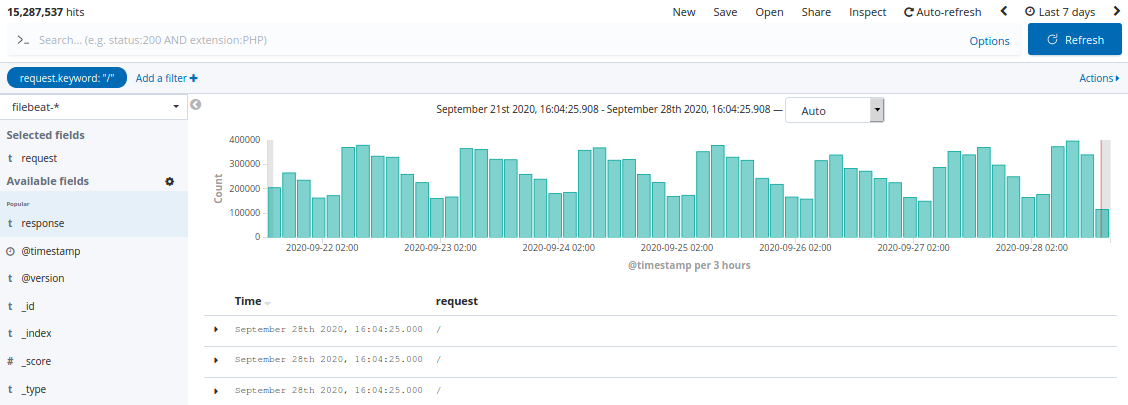

- #Elasticsearch filebeat docker how to
- #Elasticsearch filebeat docker install
- #Elasticsearch filebeat docker code
- #Elasticsearch filebeat docker plus
I went through several stackoverflow pages, github issues and elasticsearch community pages. I do have a logstash.yml but nothing is in it yet. config/filebeat.yml:/usr/share/filebeat/filebeat.yml:ro Image: /beats/filebeat:7.8.0Įntrypoint: "filebeat -e -strict.perms=false" logstash-config:/usr/share/logstash/configĬommand: Image: /elasticsearch/elasticsearch:7.8.0 So this issue might be something I configured wrong specifically. That’s why there are so many HTTP error 400s (bad request) on this server.I have looked at several issues like mine and I went through all the solutions and it still doesn't work. One observation you can make here as this web server, as any public web server, is constantly being hit by hackers looking to see what vulnerabilities you have left exposed. Although FileBeat is simpler than Logstash, you can still do a lot of things with it. It was created because Logstash requires a JVM and tends to consume a lot of resources. FileBeat is used as a replacement for Logstash. FileBeat then reads those files and transfer the logs into ElasticSearch. Here is the world map showing where your traffic comes from: Docker writes the container logs in files. Now you will see charts on the dashboard. Then type the letters nginx to find the dashboard: For now, we’ll use the dashboards that nginx has created, although you can make your own dashboards for specific use cases. So, start Filebeat like this: sudo service filebeat start Open the Kibana nginx Dashboard Loading dashboards (Kibana must be running and reachable)Īfter a while it will stop, once it has installed the dashboards. Now run this command to push the filebeat dashboards to Kibana: sudo filebeat setup -dashboards To get Elasticsearch write the logs to file you either need to do some hacky stuff with docker and the command parameters or modify the log4j2.properties file. Assuming you are using the regular nginx layout, just enable the nginx module. There is no configuration necessary, unless you have modified the log location in nginx, in which case you would need to put the paths in /etc/filebeat/modules.d/nginx.yml.
#Elasticsearch filebeat docker install
You don’t need to install Filebeat in a container as the installation is simple and requires no configuration. Now open the console: address):5601/app/kibana#/home Install Filebeat Running on Kubernetes Try Elastic Cloud on Kubernetes.
#Elasticsearch filebeat docker code
Nohup docker run -link(container id):elasticsearch -p 5601:5601 kibana:7.6.2& Docker Elastic On this page, youll find all the resources docker commands, links to product release notes, documentation and source code for installing and using our Docker images. Instead, I leave off security, set my firewall rules to allow access only from my designated IP address, and I follow these instructions.) sudo -i filebeat modules enable elasticsearch kibana system nginx filebeat setup -e -pipelines This all works fine, until I come to recreate my container, at which point the enabled modules are (unsurprisingly) disabled and I have to run this stuff again. If you don’t turn on security, people running port scans against your service will find your Kibana install and be able to use it without logging in. Instead, you’ll need to turn on security, which I don’t cover in this article.

( Important note: To put Kibana on a public IP address, do not follow these steps. Otherwise Kibana will bind to localhost, which does no good since you can’t reach it across the network. Then pass a routable IP address to Kibana using the SERVER_HOST environment variable.

Run this command to get the container ID: sudo docker ps Then you need the docker container ID to install and start Kibana. We use Docker since it’s the simplest way to install Kibana.įirst, install ElasticSearch: sudo docker pull /elasticsearch/elasticsearch:7.6.2
#Elasticsearch filebeat docker plus
Filebeat is one of several Elasticsearch data shippers others are Logstash, Metricbeat, and Packetbeat, plus a couple of specialized ones. Kibana is the graphical front-end for Elasticsearch. We will use the nginx Filebeat module and, of course, Elasticsearch.
#Elasticsearch filebeat docker how to
In this article, I’ll show how to use Kibana to monitor the nginx web server.


 0 kommentar(er)
0 kommentar(er)
